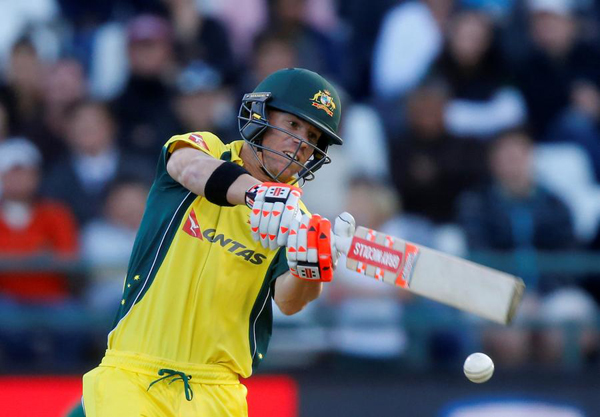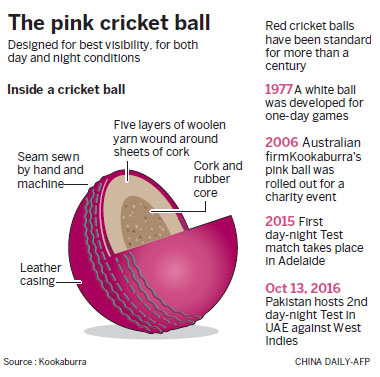Innovation is the name of the game for manufacturers
As cricket stages its second day-night Test this week, factory workers in Pakistan will be among the avid television viewers - they might even have made the innovative pink balls being used by their heroes.
|
 |
|
Australia's David Warner plays a shot against South Africa during the fifth ODI cricket match at Newlands Stadium, Cape Town, South Africa, Oct 12, 2016.?[Photo/Agencies] |
Pakistan hosts West Indies in Dubai in a five-day/night Test featuring the pink ball, starting on Thursday.
It is a match that will be closely followed in Sialkot, the city that is the country's sports manufacturing hub.
Pakistan's sporting goods industry is positioning itself to be the top supplier of the new pink balls aimed at dragging the traditional format - the five-day game - into the 21st century.
"We are probably making 15,000 to 20,000 pink balls per year. The numbers of pink balls are growing," said Khawar Anwar Khawaja, chief executive of Grays of Cambridge, which has been making cricket balls since 1953.
The high visibility balls made their Test debut last year when Australia played New Zealand in Adelaide, to mixed reviews.
But cricket's bosses are committed to increasing the number of day/night Tests as they bid to reverse the trend of falling attendances.
After years of trials, the governing body has plumped for pink to replace traditional red under lights. It is visible against both dark skies and the traditional Test-match white kits.
Two major factories and dozens of small units in Sialkot are on the case.
New color, old format
"Last year we produced about 120,000 cricket balls (all colors), but our demand is growing. We hope to do this year minimum hopefully around 150,000 balls," Khawaja added, beaming with pride as his workers stitched the balls by hand behind him.
Test cricket is the sport's longest format, with matches that despite being scheduled for five days of play, can still end in a draw.
With breaks for lunch and tea, Tests evoke a bygone era and are losing support to the modern, shortest, form of the game, Twenty20.
The high-octane Twenty20 matches last around three hours, feature colored uniforms, live performances, loud music and cheerleaders.
The first ever Test match was played in 1877 between England and Australia.

Outside those two countries and India, filling stadiums across five days and attracting advertisers has increasingly become a problem.
Pakistan in particular has suffered because it has been forced to play its home games in neutral venues such as the United Arab Emirates since militants attacked the touring SriLanka team's bus in Lahore in 2009.
Misbah-ul-Haq, Pakistan's celebrated captain who last month took it to No 1 in the world rankings, is a firm believer that the "future belongs to night Tests".
"Since the game is played for the fans and for the audience, night cricket is the future - and it's definitely good for cricket," he told reporters last week.
Proud history
The history of sporting goods manufacturing in Sialkot dates back to the 19th century, when locals first began to produce soccer balls for the British army, then the occupying power.
Today, the city's sports exports are worth $900 million annually and have supplied balls for international competitions such as 2014 FIFA World Cup.
Established in 1953,Grays of Cambridge is Pakistan's premier brand and produces red, white, pink and orange balls for the leading markets in Australia and England for top international brands such as Dukes and Gray-Nicolls.
And local manufacturers expect a deluge of orders.
"We have been producing pink for the last seven or eight years and exporting them to mainly Australia and England," said Khawaja.
Cricket balls, weighing between 142 to 163 grams depending on the category, are sold for up to $25.
They are stitched from four leather pieces which are converted into two round shaped cups after coloring the raw leather - usually from cattle - and moulding it on machines, before the final stitching by hand or machine.
The balls are then wrapped in crystal polythene covers and packed in cardboard boxes for overseas shipment.
The use of pink balls has been trialed by some domestic leagues, but has had its share of problems.
Both the Australian and New Zealand teams complained about the pink ball's ability to swing (move in the air) and that it became too soft too soon, making it harder for batsmen to score runs.
Misbah, however, said players would adapt to the conditions in time.
"Night cricket is the wave of the future," he said. "This wonderful game is for the fans, and we will attract more of them by changing with the times.
"The more frequently we play under lights, it will give more exposure and allow players to get used to it."
Bravo is up for the challenge
West Indian batsman Darren Bravo vowed to give his best shot on the challenge of facing a newly introduced pink ball in the day-night Test against Pakistan starting in Dubai on Thursday.
The 27-year-old left-hander smashed an attractive 91 in the West Indies' drawn three-day game against Pakistan Cricket Board Patron's XI in Sharjah on Sunday, also played with the pink ball in a day-night affair.
Bravo admitted batsmen could not pick up the seam of the pink ball but said the challenge was exciting.

"Most of the guys were complaining that they were not able to pick up the seam that well," Bravo said on Tuesday.
"We need to accept the challenge as quickly as possible and go out and give it our best shot."
The day-night Test with a pink ball will only be the second in Test cricket's 140-year-old history, following the Australia-New Zealand encounter under the same conditions at Adelaide in November last year.
The manufacturers of the Kookaburra ball admitted they have changed the seam of the pink ball from dark green and white - on the balls used in Adelaide - to a black that was subsequently trialed in first class cricket with improved visibility.
Bravo pointed out that batting under lights on a pink ball is difficult.
"I think when we play in the lights the ball turns more than in the sunshine and that's the difficult time to bat.
"But it's a good experience and the more time you spend in the middle it becomes easier," said Bravo, who backed day-night Tests.
"They (administrators) are trying the day-night Tests to encourage people to come, they can come after their work and have time to bring their families and that's a positive. Let's hope people come and support Test cricket again."
Bravo said West Indies was poor in the preceding Twenty20 and one-day series, where it was blanked by Pakistan 3-0.
"Quite honestly, by all means we didn't really perform well in the shorter formats of the game and we are disappointed about that but in the Tests we will try our best to put in much better performance.
"The guys have worked hard and we are very excited about this Test with the pink ball and then the last two with the normal red ball," said Bravo.
The remaining two Tests will be played in Abu Dhabi from Oct 21-25 and Sharjah from Oct 30 to Nov 3.